You’ll want devices with advanced HRV sensors like WHOOP or OURA for maximum accuracy, ensuring proper calibration during a low-stress 3-7 day baseline period. Choose breathable materials and alternate wrist positioning for comfortable 24/7 wear. Enable real-time stress alerts and guided breathing exercises while integrating data with health apps for thorough analysis. Maintain consistent charging routines and customize visualization dashboards to easily recognize stress patterns. These foundational steps reveal deeper stress management insights.
Choose Devices With Advanced Heart Rate Variability Sensors
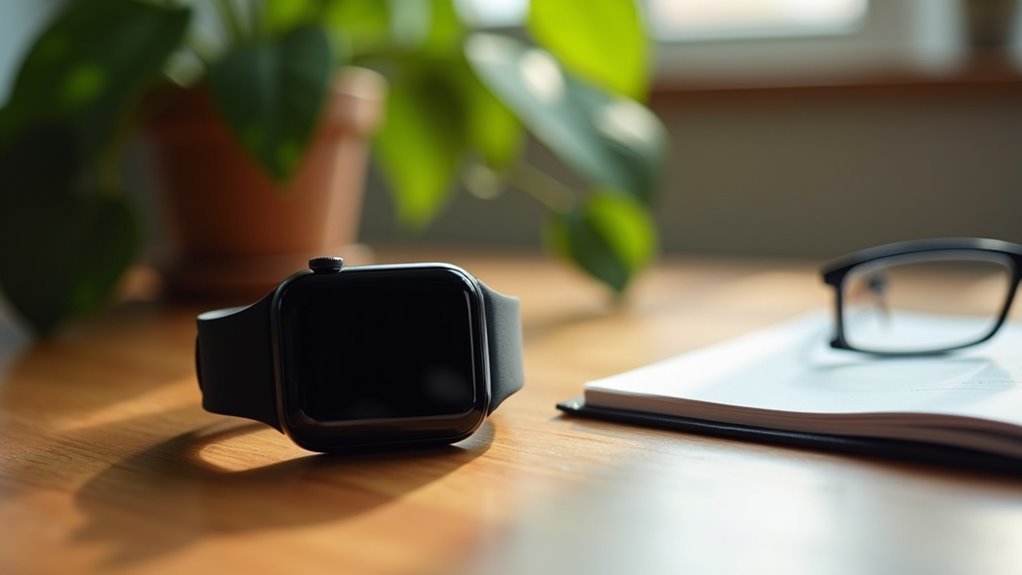
When selecting a fitness band for stress tracking, you’ll want to prioritize devices equipped with advanced heart rate variability sensors that detect subtle beat-to-beat changes rather than simple pulse measurements.
Higher-end models leverage PPG and ECG technology for greater precision, with brands like WHOOP achieving 99% accuracy in HRV measurement. Look for devices that integrate noise reduction algorithms to filter respiratory and environmental artifacts that can compromise data quality.
Advanced PPG and ECG sensors with noise reduction algorithms deliver superior HRV precision by filtering environmental interference.
Premium options from Oura, Fitbit, Apple Watch, Garmin, and Polar offer competitive sensors with varying precision levels. Independent validation studies reveal that OURA devices demonstrate strong accuracy with only 6.84% mean error rates when measured against clinical-grade ECG standards.
These advanced algorithms quantify HRV metrics more reliably, enabling early detection of stress, fatigue, and recovery needs. Quality sensors reduce false alarms and improve lifestyle recommendations through continuous 24/7 monitoring capabilities.
Optimize Comfort Settings for Continuous 24/7 Wear
You’ll need to fine-tune your band’s tightness to maintain accurate sensor contact without restricting blood flow or causing discomfort during extended wear.
Choose breathable, moisture-wicking materials that prevent skin irritation and bacterial buildup when wearing your device around the clock.
Switch your fitness band between wrists periodically to give each area a break and reduce the risk of developing pressure sores or rashes from continuous contact. Consider smart rings as an alternative form factor that distributes pressure differently and may provide greater comfort during extended wear periods.
Adjust Band Tightness
Three key factors determine the ideal tightness for your fitness band: sensor accuracy, skin health, and all-day comfort.
You’ll know it’s properly adjusted when you can slide one finger between the strap and your wrist without the sensor flickering or the band sliding excessively.
Avoid tightness that leaves indentations on your skin after removal – this restricts blood flow and causes irritation.
For silicone bands, use pre-punched holes to fine-tune the fit. With fabric bands, slide the clasp along loops until you find the sweet spot between security and comfort.
During workouts, move your band 2-3 finger widths above your wrist bone for better sensor contact.
Afterward, loosen it to let your skin breathe and prevent prolonged pressure marks. If you experience persistent issues with fit or comfort, consider seeking community support through user forums where others share practical solutions and tips.
Choose Breathable Materials
Since your fitness band stays on your skin around the clock, breathable materials become essential for preventing moisture buildup and skin irritation.
Lightweight fabrics with open weaves allow air to circulate freely, while materials like nylon and polyester wick moisture away from your skin effectively.
You’ll want to avoid non-porous silicone bands that trap sweat and heat. Instead, choose woven nylon, cotton blends, or bands with mesh panels that enhance airflow.
Perforated straps also improve ventilation considerably.
Consider materials like Lyocell or Tencel for their superior breathability and moisture-wicking properties. Natural fibers like silk provide comfort during extended wear. Tencel’s antibacterial properties help prevent odor and skin irritation during continuous monitoring.
Water-resistant options simplify cleaning and reduce bacterial buildup.
Choose bands that combine different materials—like nylon with mesh inserts—to maximize both breathability and durability for continuous stress tracking.
Switch Wrist Positions
Alternating your fitness band between wrists throughout the day can greatly improve both comfort and data accuracy for stress tracking.
You’ll notice that wearing your tracker on your non-dominant arm reduces incorrect readings during high-intensity activities and improves sleep tracking accuracy. Your less dominant wrist experiences less movement interference, particularly during rest periods when heart rate monitoring is most accurate.
Switch wrists when you’re engaging in activities like typing, which can cause muscle contractions that affect heart rate variability data.
You’ll find that movement artifacts decrease when you position the device strategically based on your current activity. Many trackers allow you to input your dominant hand in settings, optimizing accuracy.
Remember that wrist movement considerably impacts data quality, so strategic positioning enhances your stress monitoring results. Maintaining consistent wear throughout both day and night ensures comprehensive stress pattern analysis and more reliable baseline measurements.
Calibrate Your Baseline Stress Levels During Setup
You’ll need to establish your personal stress baseline during the first few days of wearing your fitness band.
This initial measurement period captures your unique stress patterns across different daily situations and activities.
Your device learns how your body typically responds to various stressors, creating a personalized reference point for future stress tracking accuracy. The enhanced functionality ensures optimal experience when monitoring your physiological responses throughout each day.
Initial Measurement Period
When you first set up your fitness band for stress tracking, the device needs to learn your unique physiological patterns through an initial measurement period that typically lasts 3-7 days.
During this time, wear your device continuously to capture extensive baseline data across different states—resting, active, and sleeping.
Your fitness band will measure heart rate, skin conductance, and movement patterns to establish personalized algorithms.
It’s essential to avoid heavy physical or emotional stressors during calibration, as these can skew your baseline readings.
Make sure the device fits properly and maintain consistent placement for accurate sensor data. Modern fitness bands utilize PPG sensors that emit green light onto your skin, with changes in light absorption corresponding to blood volume fluctuations that help establish your stress baseline.
The calibration process captures your natural physiological variation, allowing the device to differentiate between normal fluctuations and actual stress responses for more precise tracking.
Personal Stress Patterns
After your device completes its initial learning period, you’ll need to establish your personal stress patterns through targeted calibration sessions. Your fitness band uses heart rate variability, skin temperature, and movement sensors to create a baseline that’s uniquely yours.
Schedule calibration during restful periods when you’re experiencing minimal stress. Night-time recordings work particularly well since they’re less influenced by daily activities. Maintain consistent device contact and wear it snugly throughout the process.
| Calibration Phase | Duration | Best Conditions |
|---|---|---|
| Initial Setup | 2-3 days | Low-stress routine |
| Baseline Recording | Several hours | Resting/sleeping |
| Ongoing Adaptation | Continuous | Normal daily wear |
You can enhance accuracy by providing self-assessments through your device’s companion app. This combination of sensor data and personal input helps your fitness band distinguish between normal physiological variations and actual stress events. Consistent use for two weeks allows the device to establish reliable patterns and improve the effectiveness of your stress management system.
Enable Real-Time Stress Alerts and Notifications

Real-time stress alerts transform your fitness band from a passive tracker into an active wellness companion that intervenes when you need it most.
Your device uses cEDA sensors to detect skin conductivity changes and monitors heart rate variability to identify stress spikes as they happen. When stress peaks, you’ll receive discreet vibration alerts prompting you to log your feelings or take immediate action.
You can customize these notifications to match your lifestyle. Adjust alert sensitivity, set specific heart rate thresholds as triggers, and control notification frequency to prevent information overload.
Manage everything through your companion app for maximum flexibility. Since tracking stress provides insights into trends over time rather than immediate stress tests, this continuous monitoring reveals patterns of stress and recovery that are often overlooked. This real-time feedback system helps you respond to stress before it escalates, making your fitness band an essential tool for proactive stress management rather than just retrospective analysis.
Utilize Guided Breathing Exercises During High Stress Periods
When your fitness band detects elevated stress levels, it can immediately prompt you to begin guided breathing exercises that interrupt your body’s fight-or-flight response.
You’ll find customizable exercise durations that fit seamlessly into your schedule, whether you need a quick 2-minute session or a more thorough 10-minute practice.
The device’s progress tracking capabilities show you how consistently using these breathing interventions improves your stress management over time. Proper breathing can mitigate stress levels and serve as an effective tool for emotional regulation when practiced regularly.
Real-Time Breathing Alerts
As stress levels spike during intense workouts or challenging daily situations, modern fitness bands equipped with breathing sensors can detect these changes and automatically trigger real-time alerts to guide you back to ideal breathing patterns.
Devices like RESPA and Prana monitor your breathing data continuously, providing immediate feedback when you’re outside optimal ranges. These alerts help you adjust your breathing technique before stress compounds, promoting better oxygen flow and heart rate regulation.
The systems use haptic vibrations and visual cues to guide you without interrupting your activities. Advanced models incorporate ventilatory threshold monitoring to optimize your breathing patterns during different exercise intensities and stress levels.
Customizable Exercise Duration
Once your fitness band detects elevated stress levels, you’ll want immediate access to breathing exercises that fit your available time and situation.
Modern stress tracking devices offer flexible duration options that adapt to your schedule and stress severity.
Most fitness bands provide these customizable features:
- Quick relief sessions – 2-minute exercises for immediate stress reduction during busy periods
- Extended relaxation – 5-minute or longer sessions for deeper calming when you have more time
- Manual control – Start, stop, or quit exercises anytime to handle unexpected interruptions
- Personalized pacing – Heart rate data adjusts breathing rhythm and session difficulty automatically
- Custom protocols – Advanced devices let you create tailored exercise durations and breathing patterns
Advanced devices can include over 80 scientifically validated breathing exercises to ensure you’re practicing evidence-based techniques.
This flexibility guarantees you’ll consistently practice guided breathing regardless of your circumstances.
Progress Tracking Benefits
Beyond offering flexible exercise options, fitness bands excel at documenting your breathing practice achievements and stress management improvements over time.
You’ll receive immediate feedback on your stress levels, enabling timely interventions when breathing exercises are needed most. The continuous tracking helps you identify patterns in your stress responses, showing which techniques work best for specific situations.
This real-time data creates adaptive stress management strategies tailored to your individual needs. You’ll stay motivated by visualizing your progress, seeing how consistent breathing practice reduces your overall stress levels.
Your fitness band integrates this stress tracking with other health metrics, providing a thorough view of your well-being. Pattern recognition optimizes when you should use breathing exercises for maximum effectiveness. Tracking also monitors how diaphragmatic breathing helps shift your body from tense states to calmer ones during stressful moments.
Track Sleep Quality to Identify Overnight Stress Patterns
Sleep tracking transforms your fitness band into a window for viewing how stress affects your body throughout the night. Your device monitors heart rate variability, movement patterns, and temperature fluctuations to reveal stress-related sleep disruptions you mightn’t notice.
Your fitness tracker becomes a nocturnal stress detective, uncovering hidden physiological responses that reveal how daily pressures sabotage your sleep quality.
Key sleep metrics that indicate overnight stress include:
- Sleep efficiency – Lower percentages suggest stress-induced restlessness
- HRV patterns – Reduced variability signals poor recovery and elevated stress
- Awakening frequency – Multiple interruptions often correlate with anxiety levels
- Sleep stage distribution – Insufficient deep sleep indicates incomplete stress recovery
- Sleep latency – Extended time falling asleep reflects racing thoughts or tension
You’ll discover connections between daily stressors and subsequent sleep quality. Advanced sleep tracking devices can achieve 99.7% accuracy in heart rate measurement, providing highly reliable data for stress pattern analysis.
This data helps you identify which activities, foods, or situations most impact your overnight recovery, enabling targeted lifestyle adjustments.
Integrate Your Band With Health Apps for Comprehensive Analysis
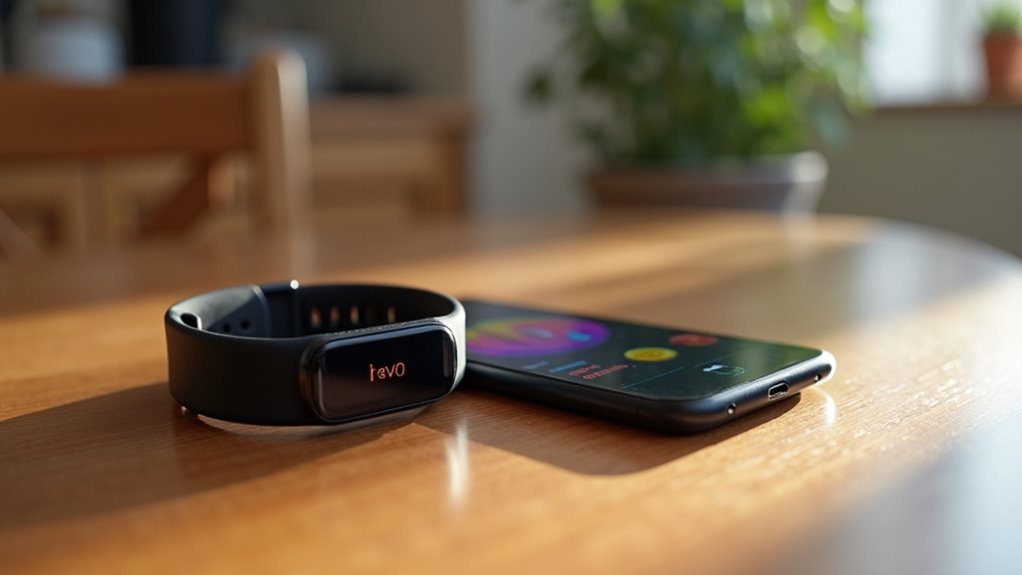
When you connect your fitness band to extensive health apps, you’ll access deeper insights that transform scattered data points into actionable stress management strategies. These platforms aggregate multiple metrics like heart rate variability, sleep quality, and electrodermal activity to create thorough stress profiles.
| Integration Feature | Benefit |
|---|---|
| Multi-metric aggregation | Creates composite stress scores combining HRV, sleep, and activity data |
| AI-driven insights | Delivers personalized breathing exercises and mindfulness prompts |
| Trend visualization | Shows long-term stress patterns alongside lifestyle factors |
You’ll receive context-aware feedback that adapts to your evolving stress patterns. Machine learning algorithms analyze your combined data streams to predict stress episodes and suggest timely interventions, while cloud backup guarantees your information stays synchronized across all devices. Advanced apps can provide immediate reminders when your stress indicators exceed healthy thresholds, helping you take preventive action before anxiety levels escalate.
Review Weekly and Monthly Stress Trend Reports
As your fitness band accumulates stress data over time, you’ll discover that weekly and monthly trend reports reveal essential patterns that daily snapshots can’t capture.
Long-term stress tracking unveils hidden patterns that single-day measurements miss, providing deeper insights into your overall wellness journey.
These thorough analyses help you understand how your stress levels correlate with sleep quality, physical activity, and seasonal changes.
Monthly reports are particularly valuable for identifying persistent stress patterns and their long-term impact on your well-being.
You’ll notice how specific events or lifestyle modifications influence your stress scores over extended periods. The biometric data collected continuously provides the foundation for these comprehensive stress assessments.
- Log events and emotions to correlate specific activities with stress increases
- Monitor seasonal variations that reflect environmental or lifestyle changes
- Set realistic stress reduction goals based on data-driven monthly insights
- Track consistency in your stress management routines and practices
- Identify social and environmental stressors through thorough trend analysis
Customize Data Visualization for Easy Pattern Recognition
Most fitness bands offer limited default visualization options that don’t align with your unique stress patterns and monitoring needs.
You’ll want to customize your dashboard by selecting specific metrics like heart rate variability and sleep quality for focused analysis. Arrange data widgets using drag-and-drop interfaces to highlight critical stress indicators at a glance.
Choose line graphs for tracking continuous stress changes throughout your day, while heat maps help you instantly recognize high-intensity stress periods through color-coding.
Layer your stress data with physical activity and nutrition information to uncover correlations affecting your stress fluctuations. Set up color-coded thresholds that visually alert you when stress metrics exceed healthy limits, making pattern recognition effortless. Use month-to-month comparison tools to identify long-term stress trends and seasonal patterns in your data.
Maintain Consistent Battery Charging for Uninterrupted Monitoring
Since your fitness band’s stress tracking capabilities depend entirely on consistent power, establishing a reliable charging routine becomes essential for capturing thorough data patterns.
You’ll want to charge your device when it reaches 30-70% rather than waiting for complete depletion, which stresses lithium polymer batteries and reduces their lifespan.
Create strategic charging windows that minimize monitoring gaps:
- Charge during showers or meals to maintain continuous stress data collection
- Set daily charging reminders at 10% battery to prevent unexpected shutdowns during important tracking periods
- Use frequent top-ups instead of full discharge cycles to preserve battery health
- Keep charging contacts clean for efficient power transfer and faster charging sessions
- Carry a spare charger to avoid missed stress events due to dead batteries
Most fitness bands require only 1-2 hours for a complete charge, making it easy to restore full power during brief breaks in your monitoring schedule.
Frequently Asked Questions
How Accurate Are Fitness Band Stress Measurements Compared to Medical Devices?
Fitness band stress measurements aren’t as accurate as medical devices due to less precise calibration and technology. You’ll get useful trends for daily monitoring, but shouldn’t rely on them for clinical diagnoses.
Can Stress Tracking Bands Distinguish Between Physical Exertion and Emotional Stress?
You’ll find most fitness bands struggle to distinguish between physical exertion and emotional stress since both increase heart rate. Advanced models using multiple sensors and AI algorithms can better differentiate these stress types.
Do Fitness Bands Require Subscription Services for Full Stress Tracking Features?
You’ll find many premium fitness bands like Oura Ring and WHOOP require subscriptions for advanced stress analysis, personalized insights, and detailed trends, though you can access basic heart rate data without fees.
How Long Does It Take to See Meaningful Stress Patterns?
You’ll notice initial stress changes within days of consistent tracking. However, meaningful patterns typically emerge after several weeks to months, depending on your consistency wearing the device and individual stress variability factors.
Can Multiple People Share One Stress Tracking Band Effectively?
You can’t effectively share one stress tracking band between multiple people. Each person’s stress baseline differs greatly, and switching profiles constantly disrupts data accuracy, compromises privacy, and creates unreliable long-term patterns.

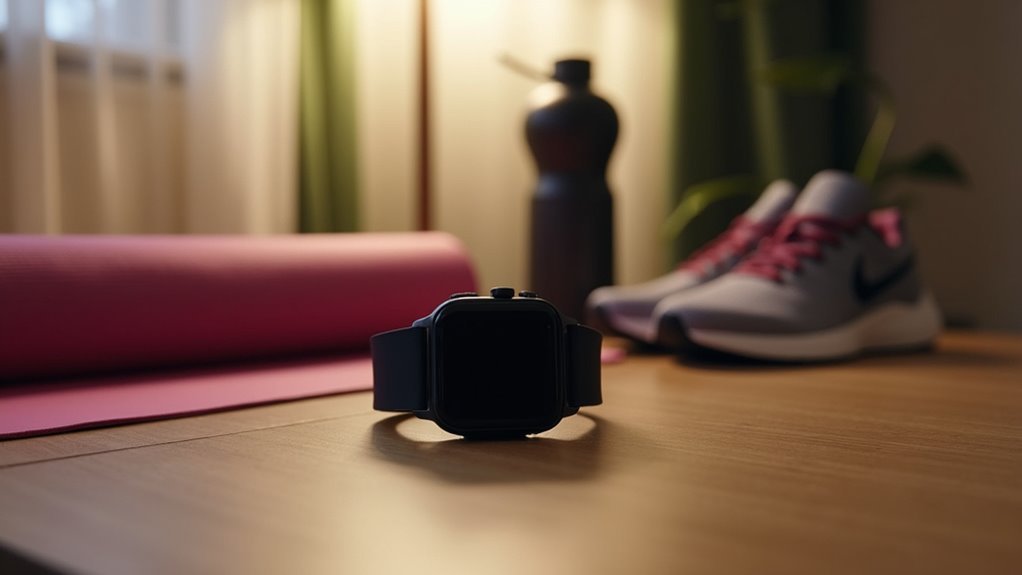

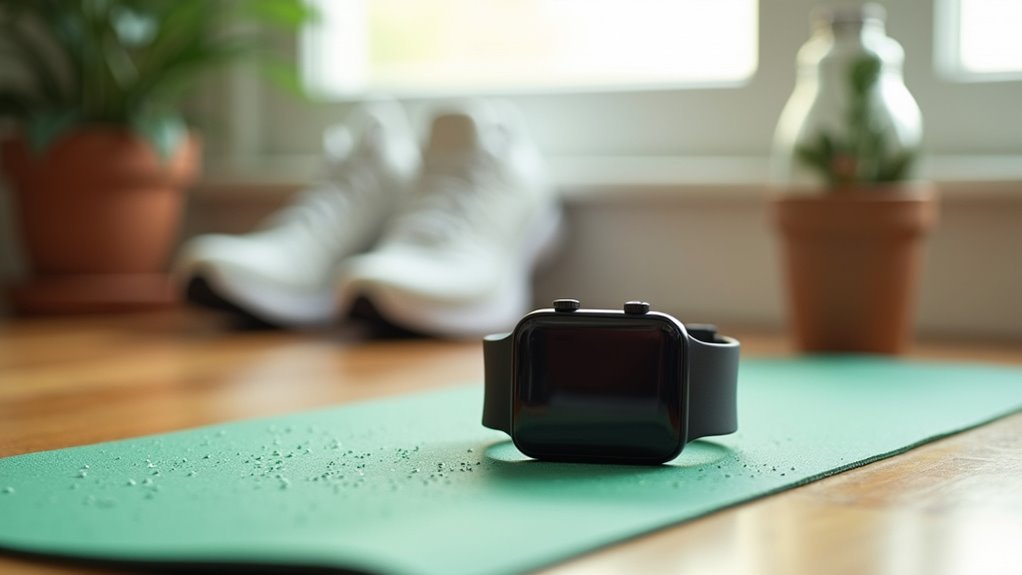
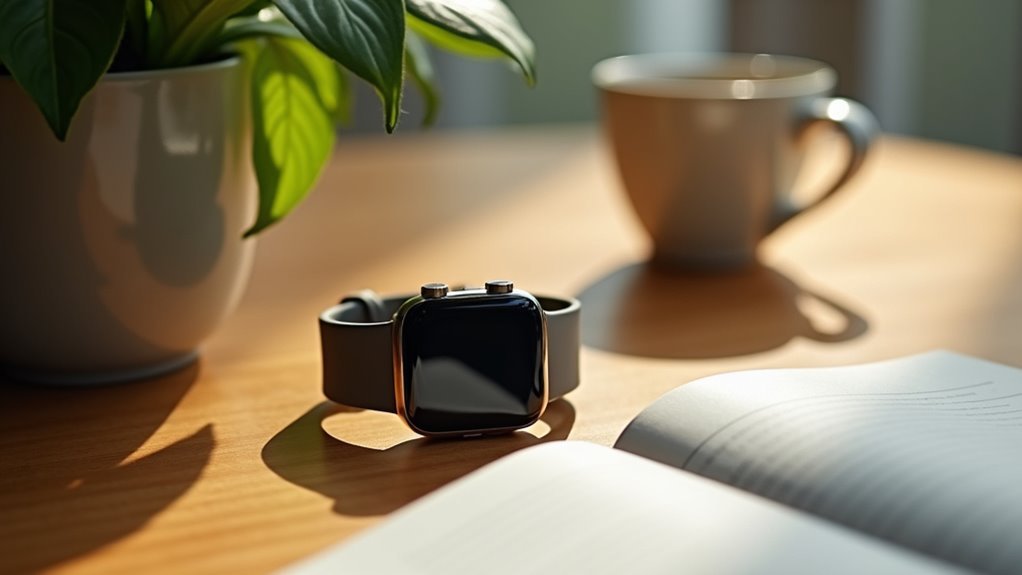
Leave a Reply